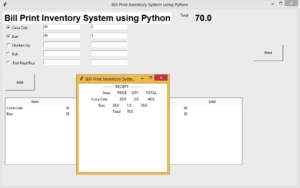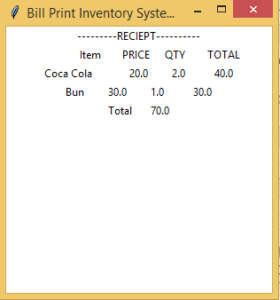The Bill print Inventory is developed by python tkinter.Inventory is most an important part in any shop for calculation the sales. The project is built to manage items and transactions. To make a new transaction, fields such as: Fried rice name, qty and payment needs to be selected. If you like to learn point of sales systems step by step, this is the right place to learn from the beginning.



from tkinter import *
from tkinter import ttk
def print():
tott = float(totText.get())
top = Toplevel()
top.geometry("300x300")
top.config(bg="white")
l = Label(top, text='---------RECIEPT----------')
l.pack()
l.config(bg="white")
heading = Label(top, text='\tItem\tPRICE\tQTY\tTOTAL')
heading.pack()
heading.config(bg="white")
for child in listBox.get_children():
item = (listBox.item(child, 'values')[0])
price = float(listBox.item(child, 'values')[1])
qty = float(listBox.item(child, 'values')[2])
tot = float(listBox.item(child, 'values')[3])
item1 = Label(top, text=f'{item}\t{price}\t{qty}\t{tot}')
item1.config(bg="white")
item1.pack()
tot = Label(top, text=f'Total\t{tott}')
tot.config(bg="white")
tot.pack()
def show():
tot = 0
if (var1.get()):
price = int(e1.get())
qty = int(e6.get())
tot = int(price * qty)
tempList = [['Coca Cola', e1.get(), e6.get(), tot]]
tempList.sort(key=lambda e: e[1], reverse=True)
for i, (item, price, qty, tot) in enumerate(tempList, start=1):
listBox.insert("", "end", values=(item, price, qty, tot))
if (var2.get()):
price = int(e2.get())
qty = int(e7.get())
tot = int(price * qty)
tempList = [['Bun', e2.get(), e7.get(), tot]]
tempList.sort(key=lambda e: e[1], reverse=True)
for i, (item, price, qty, tot) in enumerate(tempList, start=1):
listBox.insert("", "end", values=(item, price, qty, tot))
if (var3.get()):
price = int(e3.get())
qty = int(e8.get())
tot = int(price * qty)
tempList = [['Chicken Fry', e3.get(), e8.get(), tot]]
tempList.sort(key=lambda e: e[1], reverse=True)
for i, (item, price, qty, tot) in enumerate(tempList, start=1):
listBox.insert("", "end", values=(item, price, qty, tot))
if (var4.get()):
price = int(e4.get())
qty = int(e9.get())
tot = int(price * qty)
tempList = [['Roll', e4.get(), e9.get(), tot]]
tempList.sort(key=lambda e: e[1], reverse=True)
for i, (item, price, qty, tot) in enumerate(tempList, start=1):
listBox.insert("", "end", values=(item, price, qty, tot))
if (var5.get()):
price = int(e5.get())
qty = int(e10.get())
tot = int(price * qty)
tempList = [['Fish Fried Rice', e5.get(), e10.get(), tot]]
tempList.sort(key=lambda e: e[1], reverse=True)
for i, (item, price, qty, tot) in enumerate(tempList, start=1):
listBox.insert("", "end", values=(item, price, qty, tot))
sum1 = 0.0
for child in listBox.get_children():
sum1 += float(listBox.item(child, 'values')[3])
totText.set(sum1)
root = Tk()
root.title("Bill Print Inventory System using Python")
root.geometry("1000x600")
global e1
global e2
global e3
global e4
global totText
global balText
totText = StringVar()
balText = IntVar()
Label(root, text="Bill Print Inventory System using Python", font="arial 22 bold" ,bg="white").place(x=5, y=10)
var1 = IntVar()
Checkbutton(root, text="Coca Cola", variable=var1).place(x=10, y=50)
var2 = IntVar()
Checkbutton(root, text="Bun", variable=var2).place(x=10, y=80)
var3 = IntVar()
Checkbutton(root, text="Chicken Fry", variable=var3).place(x=10, y=110)
var4 = IntVar()
Checkbutton(root, text="Roll", variable=var4).place(x=10, y=140)
var5 = IntVar()
Checkbutton(root, text=" Fish Fried Rice ", variable=var5).place(x=10, y=170)
Label(root, text="Total").place(x=600, y=10)
e1 = Entry(root)
e1.place(x=140, y=50)
e2 = Entry(root)
e2.place(x=140, y=80)
e3 = Entry(root)
e3.place(x=140, y=110)
e4 = Entry(root)
e4.place(x=140, y=140)
e5 = Entry(root)
e5.place(x=140, y=170)
e6 = Entry(root)
e6.place(x=300, y=50)
e7 = Entry(root)
e7.place(x=300, y=80)
e8 = Entry(root)
e8.place(x=300, y=110)
e9 = Entry(root)
e9.place(x=300, y=140)
e10 = Entry(root)
e10.place(x=300, y=170)
tot = Label(root, text="", font="arial 22 bold", textvariable=totText)
tot.place(x=650, y=10)
Button(root, text="Add", command=show, height=3, width=13).place(x=10, y=220)
Button(root, text="Print", command=print, height=3, width=13).place(x=850, y=120)
cols = ('item', 'price', 'qty', 'total')
listBox = ttk.Treeview(root, columns=cols, show='headings')
for col in cols:
listBox.heading(col, text=col)
listBox.grid(row=1, column=0, columnspan=2)
listBox.place(x=10, y=300)
root.mainloop()after calculating the total Print receipt will be released.



I have attached the video tutorial below it will help you to do this step by step.